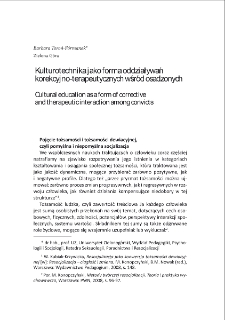Digital Library of Zielona Góra contains 9 272 digital objects
Object
Title: Kulturotechnika jako forma oddziaływań korekcyjno-terapeutycznych wśród osadzonych = Cultural education as a form of corrective and therapeutic interaction among convicts
Contributor:
Kataryńczuk-Mania, Lidia - red. nauk.
Group publication title:
Abstract_pl:
Osoby nieprzystosowane społecznie, które mają trudności zarówno z tworzeniem, jak i realizowaniem i wypełnianiem nowymi treściami tożsamościowymi ról stawianych przez społeczeństwo, posiadają zubożałe, nieakceptowane społecznie, fragmentaryczne osobowości. Posiadanie tzw. tożsamości negatywnej oznacza, że człowiek stale tworzy własną tożsamość i nigdy nie jest ona ustalona raz na zawsze. ; Pozbawienie wolności człowieka o tożsamości negatywnej ma sens tylko wówczas, kiedy służy odnowie człowieka, zmusza go do zastanowienia się nad własnym postępowaniem i odmianą życia oraz włączeniem na nowo w życie społeczeństwa. Służy temu zwłaszcza twórcza resocjalizacja rozumiana jako odnajdywanie i rozwijanie ukrytych potencjałów osób nieprzystosowanych społecznie. ; W warunkach więziennej izolacji kulturotechnika nabiera szczególnego znaczenia, nie tylko ze względu na korzyści instrumentalne (związane z wypełnieniem czasu wolnego oraz ograniczeniem wpływu podkultury na jednostkę pozbawioną wolności), lecz także związane z próbami kształtowania społecznie akceptowanej tożsamości. W obszar ten wpisuje się szeroko rozumiana sztuka. ; Jej readaptacyjna wartość opiera się na tym, że mobilizuje jednostkę do działania, osłabia poczucie izolacji społecznej, pustki, apatii i zniechęcenia, ma więc dodatni wpływ na osobowość ludzką. Kreacja wyzwala bowiem pozytywne emocje będące źródłem pożądanego w twórczej resocjalizacji "dobrostanu psychicznego" służącego oddziaływaniom korekcyjno-terapeutycznym.
Abstract:
Socially maladjusted people, who have difficulties in creating, fulfilling and filling the roles determined by the society with new identity content, have impoverished, socially unaccepted, and fragmentary personalities. Having such a so-called negative identity means that the person constantly creates their own personality and it is never set permanently. ; Depriving a person of their negative identity is only meaningful when it serves to rehabilitate them, by making them reconsider their own behavior as well as changing their lives and becoming engaged once again with and in society. With the above in mind, creative rehabilitation is understood as finding and developing hidden potential in people socially maladjusted. ; Cultural education in prison isolation comes with a particular meaning not only because of the instrumental benefits (that is filling the prisoners` free time and limiting the influence of a subculture on a person who has been deprived of their freedom), but also because of the benefits associated with the attempts to create a socially accepted and acceptable identity. ; The concept of "cultural education" considers the widely-understood arts. It`s value as a tool for helping people reintegrate into society is based on the fact that it motivates the person to act, and weakens feelings of social isolation, emptiness, apathy and discouragement. This is most likely to be achieved by triggering positive emotions, which aids the corrective and therapeutic interactions. In conclusion, the use of the method should have a positive influence on certain personality types and, therefore, it should assist in the reintegration of people into society.
Publisher:
Zielona Góra ; Skarbona: Stowarzyszenie Polskich Muzyków Kameralistów
Format:
Resource Identifier:
Pages:
Source:
Z zagadnień terapii artystycznej, logopedycznej i pedagogicznej
Language:
Rights:
Biblioteka Uniwersytetu Zielonogórskiego
Object collections:
- Repository > Faculties > Faculty of Education, Psychology and Sociology
- Repository > Types of work > Books
- Repository > Types of work > Chapters in books
Last modified:
Apr 15, 2025
In our library since:
Feb 21, 2023
Number of object content hits:
230
All available object's versions:
https://zbc.uz.zgora.pl/repozytorium/publication/78010
Show description in RDF format:
Show description in OAI-PMH format:
Objects Similar
Pierzchała, Kazimierz Przybysz-Zaremba, Małgorzata - red. nauk. Kataryńczuk-Mania, Lidia - red. nauk.
Rubczewska, Anna Kataryńczuk-Mania, Lidia - red. nauk.
Idzikowski, Bogdan Mianowska, Edyta Kowalski, Mirosław - red. Kowalska, Ewa - red.
Węgorowska, Katarzyna Tichoniuk-Wawrowicz, Ewa - red. Karczewska, Małgorzata - red.
Ferenz, Krystyna Kataryńczuk-Mania, Lidia - red. nauk.
Strouhal, Martin
Prokosz, Małgorzata Kataryńczuk-Mania, Lidia - red. nauk.
Przerembska, Violetta Kataryńczuk-Mania, Lidia - red. nauk. Mania, Grzegorz - red. nauk.

